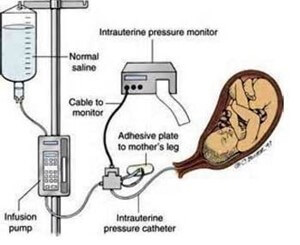A nurse is reviewing the risk factors for cord prolapse with a group of nursing students.
Which of the following statements by a student indicates an understanding of the teaching?
“Cord prolapse is more likely to occur in clients who have a low-lying placenta.”
“Cord prolapse is more likely to occur in clients who have a vertex presentation.”
“Cord prolapse is more likely to occur in clients who have oligohydramnios.”
“Cord prolapse is more likely to occur in clients who have a singleton pregnancy.”.
The Correct Answer is C
The correct answer is choice C. Cord prolapse is more likely to occur in clients who have oligohydramnios.
Oligohydramnios is a condition where there is too little amniotic fluid around the fetus. This can cause the umbilical cord to slip down into the cervix and vagina ahead of the baby during delivery. This can cut off the blood and oxygen supply to the baby and cause fetal distress.
Choice A is wrong because cord prolapse is more likely to occur in clients who have a placenta previa, not a low-lying placenta.
Placenta previa is a condition where the placenta covers the cervix partially or completely. This can prevent the baby from descending into the pelvis and leave more space for the cord to prolapse.
Choice B is wrong because cord prolapse is more likely to occur in clients who have a non-vertex presentation, such as breech or transverse lie, not a vertex presentation.
A non-vertex presentation means that the baby’s head is not pointing down towards the birth canal. This can result in a smaller or irregularly shaped presenting part that does not fit snugly into the pelvis and allows the cord to slip past it.
Choice D is wrong because cord prolapse is more likely to occur in clients who have a multiple pregnancy, not a singleton
Nursing Test Bank
Naxlex Comprehensive Predictor Exams
Related Questions
Correct Answer is ["A","B","C","E"]
Explanation
The correct answer is choice A, B, C and E. Here is why:
• Choice A is correct because informed consent is required before performing any invasive procedure, such as amnioinfusion.
• Choice B is correct because an intrauterine pressure catheter (IUPC) is needed to infuse fluid into the amniotic cavity and to monitor the uterine contractions.
• Choice C is correct because warmed sterile normal saline is the fluid of choice for amnioinfusion, as it mimics the natural amniotic fluid and reduces the risk of infection.
• Choice D is wrong because the client’s temperature should be monitored every 15 to 30 minutes, not every 4 hours, to detect any signs of infection or chorioamnionitis.
• Choice E is correct because the fetal heart rate and uterine activity should be assessed continuously to evaluate the fetal well-being and the effectiveness of amnioinfusion.
Amnioinfusion is a procedure that involves infusing fluid into the amniotic cavity to increase the amniotic fluid volume and to relieve umbilical cord compression.It can be used for clients who have oligohydramnios (low amniotic fluid) and cord compression, which can cause fetal growth restriction and abnormal fetal heart rate patterns.Amnioinfusion can improve the fetal blood flow and oxygenation by reducing the cord compression and variable decelerations.

Correct Answer is A
Explanation
The correct answer is choice A. Apply pressure to the presenting part with gloved fingers.This is because applying pressure can prevent further compression of the umbilical cord and reduce the risk of fetal hypoxia (lack of oxygen).The umbilical cord can be flattened or twisted during delivery, which can cause nerve or brain damage.
Choice B is wrong because placing the client in Trendelenburg position (head down and feet up) may not be enough to relieve the cord compression and may cause discomfort or respiratory distress for the client.
Choice C is wrong because administering oxygen may not improve the fetal oxygenation if the cord is severely compressed.
Oxygen administration may also delay the urgent delivery of the baby.
Choice D is wrong because clamping and cutting the umbilical cord will cut off the fetal blood supply and oxygenation.
This can lead to fetal death or severe brain injury.
Normal ranges for umbilical cord pH are 7.18 to 7.38 for arterial blood and 7.28 to 7.45 for venous blood.
Whether you are a student looking to ace your exams or a practicing nurse seeking to enhance your expertise , our nursing education contents will empower you with the confidence and competence to make a difference in the lives of patients and become a respected leader in the healthcare field.
Visit Naxlex, invest in your future and unlock endless possibilities with our unparalleled nursing education contents today
Report Wrong Answer on the Current Question
Do you disagree with the answer? If yes, what is your expected answer? Explain.
Kindly be descriptive with the issue you are facing.
